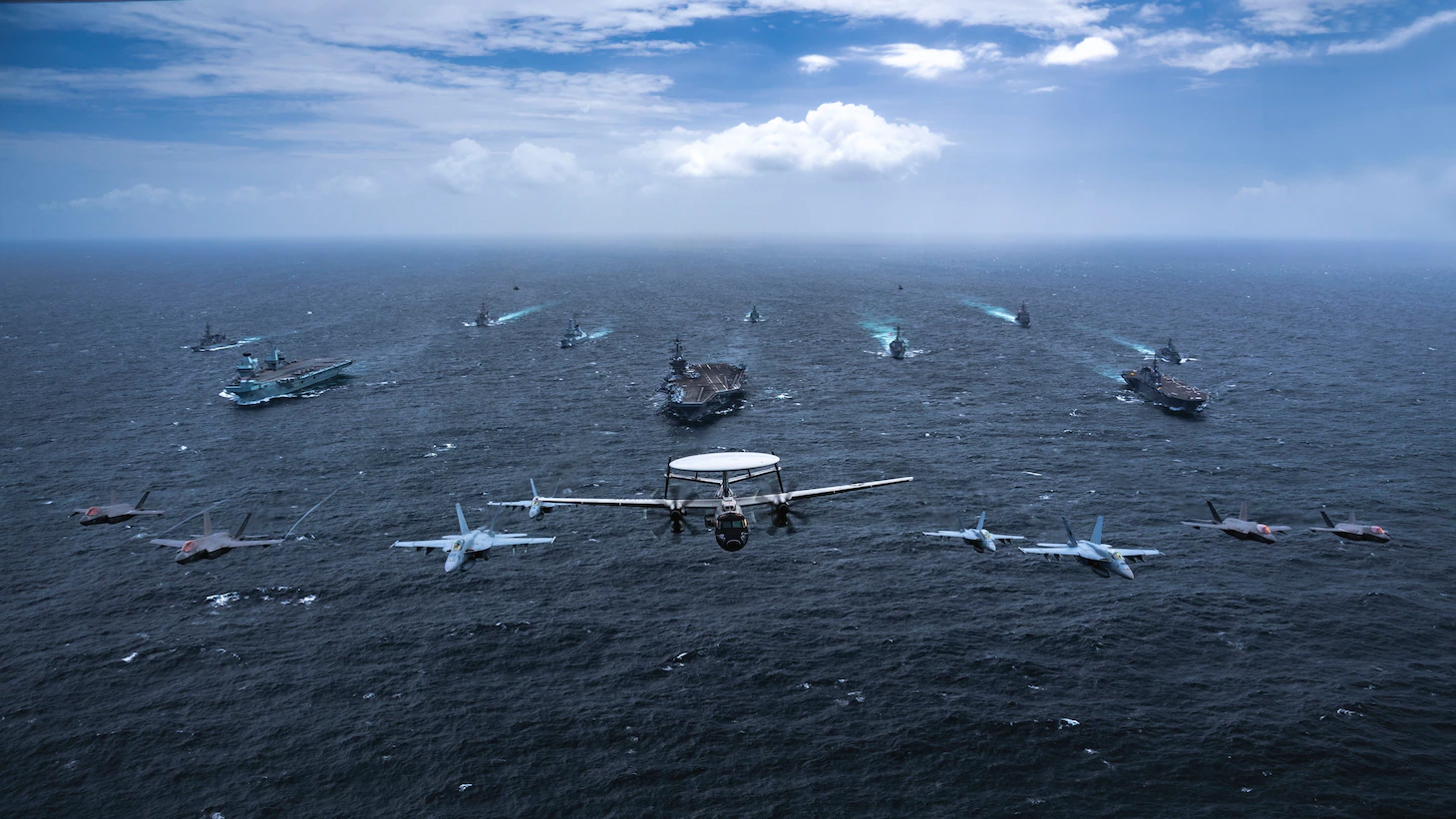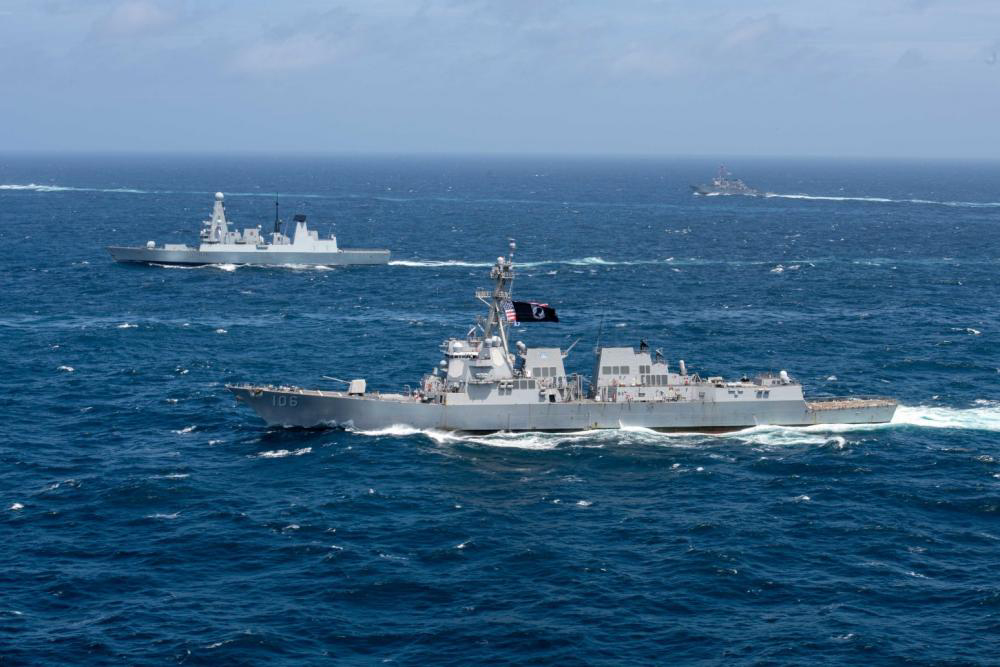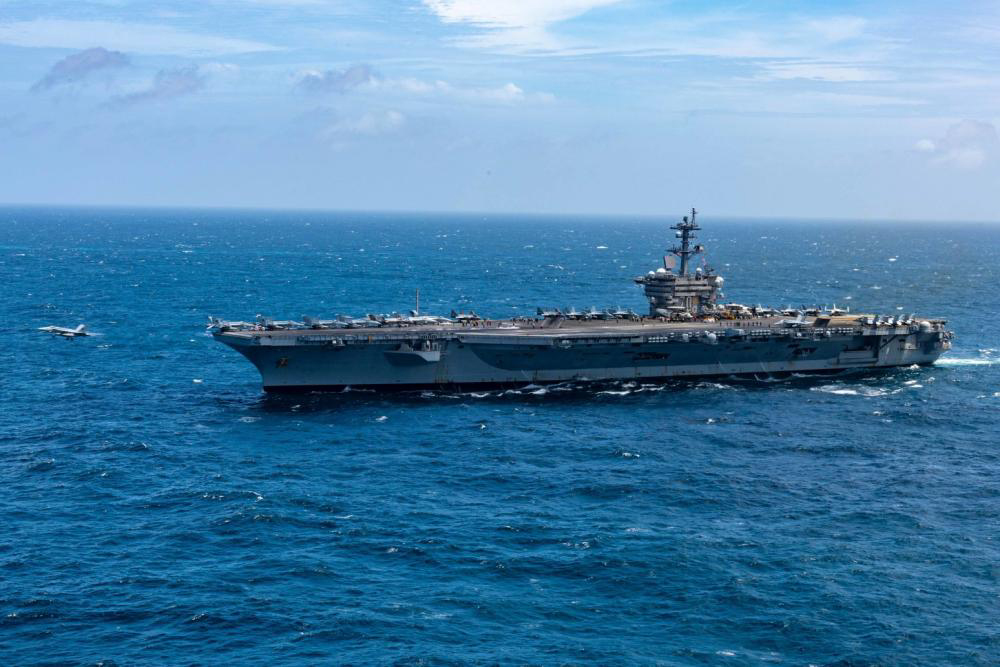Photos: Warships from Australia, Japan, UK, US Conduct Joint Training

In one of the largest naval training exercises of its kind, naval forces from Australia, Japan, the U.K., and the U.S. joined together in multilateral for a four-day training exercise in the eastern Indian Ocean. Fifteen vessels coordinated during the exercise.
During the multinational exercise, known as Maritime Partnership Exercise (MPX) 2021, the four navies, the Royal British Navy, Royal Australian Navy, Japan Maritime Self-Defense Force, and U.S. Navy, engaged in planning, maritime communication operations, anti-submarine warfare operations, air warfare operations, live-fire gunnery events, replenishments-at-sea, cross-deck flight operations, and maritime interdiction operations.

Ships and aircraft from the U.S. Navy, Royal Australian Navy, Japan Maritime Self-Defense Force, and U.K. Royal Navy transit in formation (U.S. Navy/MC2 Haydn N. Smith)
“MPX is high-end, multi-domain maritime training at its finest,” said Rear Adm. Dan Martin, commander, Carrier Strike Group 1. “All four participating nations have enduring interests in the security, stability, and well-being of the Indo-Pacific region. We will continue to fine-tune our collective assets - speed, precision, lethality - in order to maximize our warfighting proficiency with our regional trusted partners.”
Elements of the Royal Australian, British, Japanese, and American maritime forces routinely operate together in the Indo-Pacific the U.S. Navy explained saying that it is a cooperative approach toward regional security and stability. This exercise brings multiple allies and partners together to strengthen interoperability and increase operations in the Indian Ocean region.
“The U.S. Navy routinely conducts integrated training operations with its international partners to demonstrate our commitment and investment in the Indo-Pacific region,” said Capt. Gilbert Clark, commodore, Destroyer Squadron (DESRON) 1. “In addition to preserving rules-based international order in the global maritime commons, the U.S. Navy’s unwavering pledge to maritime security in the Indo-Pacific is critical to international trade and commerce.”

USS Carl Vinson conducts a fueling-at-sea with Royal Australian Navy Anzac-class frigate HMAS Ballarat (U.S. Navy photo by Mass Communication Specialist 2nd Class Christian Huntington)
U.S. Navy participants in the exercise included Carrier Strike Group 1, consisting of the aircraft carrier USS Carl Vinson, Carrier Air Wing 2, Ticonderoga-class guided-missile cruiser USS Lake Champlain, Arleigh Burke-class guided-missile destroyer USS Stockdale, and Fleet Replenishment Oiler Henry J. Kaiser-class USNS Yukon. Collectively, the Vinson group consists of more than 7,000 sailors,
The carrier group is on a scheduled deployment in the U.S. 7th Fleet area of operations. This marks the first time that a CSG is deployed in the 7th Fleet area of operations with the Air Wing of the Future (AWOTF), including the first operational deployment for both the F-35C Lightning II Joint Strike Fighter and Navy CMV-22B Osprey.
“Multilateral and bilateral exercises demonstrate our steadfast pledge to our partners and our collective desire to maintain a free, open, and inclusive Indo-Pacific,” said Capt. P. Scott Miller, commanding officer, USS Carl Vinson. “The closer we train together, the more quickly and easily we can come together when our combined forces are needed.”
Participating from the Royal Australian Navy were the Anzac-class frigate HMAS Ballarat and HMAS Sirius.

Arleigh Burke-class guided-missile destroyer USS Stockdale, Arleigh Burke-class guided-missile destroyer USS The Sullivans, and U.K. Royal Navy Richmond-class frigate HMS Richmond (U.S. Navy photo by Mass Communication Specialist 2nd Class Russell Lindsey)
"Our ongoing cooperation with Japan, the United Kingdom, and the United States further strengthens our professional mariner relationships and enhances our interoperability," said Cmdr. Antony Pisani, commanding officer HMAS Ballarat. "Both Ballarat and Sirius have spent significant time deployed to the region this year and Maritime Partnership Exercise adds to the list of excellent navy-to-navy activities we've enjoyed with the United States."
Royal British Navy participants included Carrier Strike Group (CSG) 21, consisting of HMS Queen Elizabeth, HMS Defender, HMS Kent, HMS Richmond, RFA Tidespring, RFA Fort Victoria, and USS The Sullivans.
Participants from Japan included Izumo-class multipurpose operation destroyer JS Kaga, and Murasame-class destroyer JS Murasame.
In addition to the MPX exercise, the U.S. carrier group recently conducted a variety of bilateral exercises with the Japan Maritime Self-Defense Force and tri-carrier operations with the Royal Navy’s HSM Queen Elizabeth and U.S. Navy’s Nimitz-class aircraft carrier USS Ronald Reagan.

F/A-18E Super Hornet launches off the flight deck of Nimitz-class aircraft carrier USS Carl Vinson (U.S. Navy photo by Mass Communication Specialist 2nd Class Russell Lindsey)

MH-60S Sea Hawk takes off the flight deck of Nimitz-class aircraft carrier USS Carl Vinson (U.S. Navy photo by Mass Communication Specialist Seaman Mason Congleton)

F/A-18E Super Hornet launches from the flight deck of Nimitz-class aircraft carrier USS Carl Vinson (U.S. Navy photo by Mass Communication Specialist Seaman Mason Congleton)
